Abstract
This paper considers the possibility for large-scale production of plutonium isotope 238Pu in the light-water nuclear power reactor VVER-1000. 238Pu is a unique source of long-term autonomous energy supply in various devices for remote regions of the Earth and in outer space. The design of the irradiation device with 237NpO2 as a starting material is proposed, which is placed in the central zone of the VVER-1000 reactor core and makes it possible to achieve 8% of the specific Pu production (Pu/237Np) by optimizing the pitch of NpO2-rod lattice. The computations showed that the scale of 238Pu production in the irradiation device was remarkably larger (2 ÷ 7 times more) than similar values in research reactors. At the same time, the use of heavy neutron moderators with low neutron absorption (natural lead or lead isotope 208Pb) around the NpO2 fuel assembly (FA) made it possible to obtain high-purity 238Pu with the content of 236Pu below 2 ppm. The paper also shows that if the irradiation device is placed in central zone of the VVER-1000 reactor core, then the displacement damage dose in the reactor vessel remains low enough to conserve its strength properties throughout the entire period of the reactor operation (60 years).
1. Introduction
Plutonium isotope 238Pu is characterized by a series of specific properties that make it a valuable source of thermal and electrical energy in radioisotope thermo-electrical generators (RITEG) and cardio-stimulators. RITEG are the main sources of power supply in cosmic devices. The USA annual demand in 238Pu for cosmic RITEG is evaluated as being large as 1.5–2 kg, and capabilities of the research reactors HFIR and ATR keep up with the demand [1,2].
The basic worth of 238Pu is an intense heat generation rate (≈570 W/kg) that can be transformed by RITEG into electricity with sufficiently high efficiency (12–15%). Long enough half-life (T1/2 = 87.7 years) provides long-term stable power supply of cosmic devices and cardio-stimulators.
Good neutron-multiplying properties of 238Pu make it a dangerous material from the standpoint of nuclear weaponry non-proliferation. Fortunately, high values of heat generation rate and emission rate of spontaneous fission neutrons (2600 n/g∙s) result in a practical impossibility to create nuclear explosive device (NED) with plutonium charge containing a large fraction of 238Pu. The IAEA document [3] declares that plutonium containing above 80% 238Pu cannot be used as a NED charge, and so such plutonium is removed from the IAEA safeguards.
1.1. 238Pu Production in Nuclear Reactors
The most suitable starting material for 238Pu production in nuclear reactors is a neptunium isotope 237Np [4]. Neutron irradiation converts 237Np to 238Pu after short-term β-decay of intermediate isotope 238Np (T1/2 = 2.1 days). Chain of nuclear reactions leading to the formation of 238Pu is shown in Figure 1.
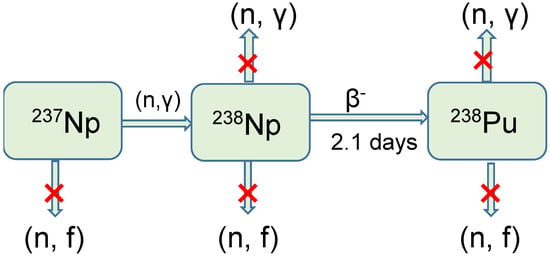
Figure 1.
Chain of isotopic transformations under neutron irradiation of 237Np. The symbol «X» designates the undesirable processes for 238Pu production.
As is seen, the problem of 238Pu production from 237Np must be resolved under very contradictory conditions. The undesirable channels can remarkably decrease the yield of target isotope. Consequently, 238Pu cost is rather high and may be at the level of USD 4000 per one gram of 238Pu [5].
Effective production of 238Pu could be achieved if it would be possible to determine such a neutron flux and such a neutron spectrum, which would be able to satisfy the following conditions:
- –
- 237Np must mainly capture neutrons, without fission, and convert to 238Np.
- –
- 238Np must mainly disintegrate with conversion to 238Pu, without radiative neutron capture and neutron-induced fission reactions. The latter condition restricts an acceptably large value of neutron flux in the irradiated material.
- –
- Fission and capture reactions of 238Pu must be minimized to avoid reduction of 238Pu mass and to prevent formation of heavier plutonium isotopes. Figure 2 shows the micro cross-sections of 238Pu capture and fission processes leading to a reduction in the mass of the generated target isotope [6].
 Figure 2. Micro cross-sections of fission reaction and radiative neutron capture by 238Pu.
Figure 2. Micro cross-sections of fission reaction and radiative neutron capture by 238Pu.
We are trying to reach minimal consumption of the target isotope:
where —neutron flux. Therefore, it seems reasonable to form a neutron spectrum within the energy range with a minimal value of micro cross-sections, i.e., within the energy range from 10 eV up to 100 eV. As it is quite impossible to keep the neutron spectrum within so narrow an energy range, the recommended energy range may be widened from 1 eV up to 600 eV, i.e., up to the resonance range of neutron absorption by 237Np (Figure 2). As is seen from Figure 2, there is a minimal value (1), while micro cross-sections and do not exceed 10 barns.
1.2. Isotope 237Np as a Starting Material for 238Pu Production
Micro cross-sections of radiative neutron capture by 237Np as functions of incident neutron energy are presented in Figure 3 [6].
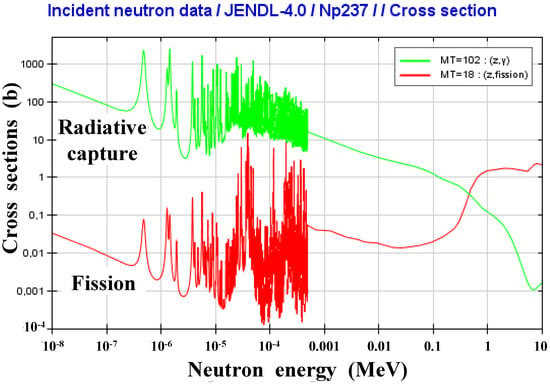
Figure 3.
237Np micro cross-sections of radiative neutron capture and fission reactions.
As is seen, it is desirable that the energy spectrum of incident neutrons would be, at least, well below 100 keV. Within this energy range, 237Np will mainly capture neutrons with a minimal rate of useless fissions. The lower neutron energies can open a favorable tendency in growth of capture-to-fission ratio, up to four orders of magnitude in a thermal energy point (Figure 4).
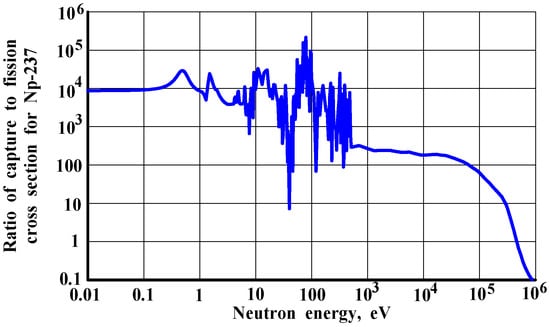
Figure 4.
Ratio of capture to fission cross-sections for 237Np.
Unfortunately, the energy range of thermal and epithermal neutrons seems undesirable for irradiation of 237Np because of intense reduction rate of 238Pu quantity within this energy range (Figure 2). Therefore, the energy range of resonance neutron absorption by 237Np (1 ÷ 600 eV) may be regarded as a preferable range of neutron spectrum. Within this energy range, the capture-to-fission ratio reaches 3–4 orders of magnitude while the resonance neutron capture integral is equal to 700 barns.
Isotope 237Np is a component of transuranium radioactive wastes (TRUW) extracted from spent fuel of nuclear power reactors. Isotope 237Np is a long-lived chemically harmful and radiotoxic material. Moreover, 237Np is a suitable fissionable material for NED manufacturing (237Np critical mass is about 57 kg). That is why extraction of potentially dangerous 237Np from TRUW and its application for production of useful 238Pu can be considered as a well-founded action. It is very important to provide sufficiently high 238Pu fraction in plutonium produced by neutron irradiation of 237Np. However, there is one other limitation on plutonium isotope composition. Neutron irradiation of 237Np can initiate fruitful 237Np(n,γ)238Np reaction and useless 237Np(n,2n)236Np reaction. The presence of isotope 236Pu in plutonium is undesirable because its decay products are an intense source of high-energy gamma-rays (mainly isotope 208Tl). Thus, 238Pu production in all countries is placed under stringent control of 236Pu content.
Typical isotope composition of plutonium produced until 1988 at the Savannah River Site (Aiken, SC, USA) is presented in Table 1 [7].

Table 1.
Isotope composition of plutonium from Savannah River Site (Aiken, SC, USA).
Presently, isotope composition of plutonium suitable for cosmic US RITEG must satisfy the following NASA requirements: content of 238Pu—above 85%, content of 236Pu—below 2 ppm [1].
1.3. 238Pu Production in the Russian Federation and in the USA
In Russia, production of 238Pu-based RITEG for navigation service was completely ceased. However, 238Pu-based RITEG represents a significant component of cosmic programs on further exploration of outer space [8]. In contrast with the USA, Russia did not cease 238Pu production, although it requires very large expenses.
Production association (PA) “Mayak” is a leading Russian producer of 238Pu. Share of PA “Mayak” in global production of radioactive isotopes reaches 20% [9]. The largest part of radioactive isotopes produced at PA “Mayak” is being exported abroad. In 1992, PA “Mayak” concluded the contract on delivery of 5 kg 238Pu to the USA (cost of the contract is about USD 6 million). According to the expert estimations, such an amount of 238Pu would be sufficient to launch 3–5 satellites with 238Pu-based RITEG [10]. Supposedly, all post-Soviet launches of the U.S. satellites were made with the application of 238Pu produced by Russia in RITEG [10].
Currently, two third-generation research reactors “Ruslan” and “Lyudmila” are in operation at the PA “Mayak”. Both reactors have unique neutron-physical features, and they are able to produce a wide circle of radioactive isotopes for non-military applications [11]. In September 2015, the specialists of the PA “Mayak” started designing a new reactor with planned start-up in 2023 [11]. The reactor is thought of as a multi-purpose facility, namely, for generation of electricity and for large-scale production of many radioactive isotopes.
Some publications (for instance, references [1,2]) are devoted to thorough analysis of possibilities for 238Pu production in the U.S. research reactors. Thermal neutron spectra in the research reactors ATR (Idaho National Laboratory) and HFIR (Oak Ridge National Laboratory) are able to intensify fruitful 237Np(n,γ)238Np reaction and, at the same time, to suppress undesirable 237Np(n,2n)236Np reaction, which can be initiated only by fast neutrons with energies above 6 MeV.
Some numerical results on potential production of 238Pu in the Advanced Test Reactor (ATR) are presented in [2]. If fuel pellets containing 20% NpO2 and 80% Al are introduced into the reactor core, then annual 238Pu production can reach 300 g with 238Pu fraction in plutonium above 96% and 236Pu fraction below 2 ppm.
Currently, ORNL renewed production of 238Pu in the research reactor HFIR [12]. In 2019, the annual rate of 238Pu production was equal to 400 g [13]. After modernization of the HFIR reactor design, its annual rate of 238Pu production can be increased up to 1.15 kg with 238Pu fraction in plutonium at the level of 85% and 236Pu fraction at the level of 2.35 ppm [1].
The present paper considers a possibility for large-scale 238Pu production in light-water power reactor of VVER-1000 type [14].
2. Materials and Methods
2.1. Method of 238Pu Production
The irradiation device (ID) is proposed to be placed in the central zone of the reactor VVER-1000 core (Figure 5). The main parameters of the reactor and the irradiation device are as follows:

Figure 5.
ID disposition in the VVER-1000 core.
- Number of fuel assemblies (FA) in the reactor core—163.
- Fuel—dioxide of enriched (4.4% 235U) uranium, density—10.7 g/cm3.
- Fuel cladding—Zr-based alloy (99% Zr; 1% Nb), density—6.5 g/cm3.
- Coolant—light water, density—0.73 g/cm3.
- Turn-key size of hexagonal FA—23.4 cm.
- Diameter of fuel pellet—7.57 mm.
- Diameter of central hole—1.40 mm.
- Thickness of fuel-cladding gap—0.075 mm.
- Thickness of fuel cladding—0.65 mm.
- Pitch of triangular fuel lattice—12.75 mm.
- Height of fuel column—353 cm.
- Thermal power—3200 MW.
The irradiation device consists of seven fuel assemblies. Central FA is a standard VVER-1000 assembly where the dioxide of enriched uranium was replaced by neptunium dioxide NpO2 (Figure 6). NpO2-rods consisted of only neptunium dioxide in Zr-Nb cladding without any additions. Composition of six surrounding FA was chosen in such a way to intensify 238Pu production rate in NpO2-FA.
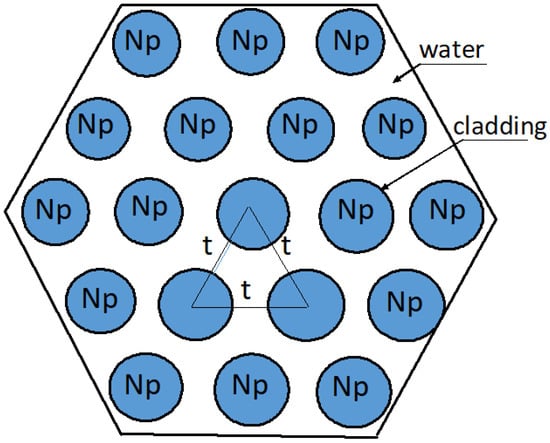
Figure 6.
FA with NpO2-rods.
The preferable neutron spectrum (energy range for resonance neutron absorption by 237Np) is formed by heterogeneous ID structure. Six fuel assemblies containing heavy neutron moderators with weak neutron absorption (natural lead, lead isotope 208Pb) surround the central NpO2-FA. A tight lattice of, for instance, lead rods is used to strengthen the neutron slowing-down effect (pitch of rods is equal to their diameter, (Figure 7).
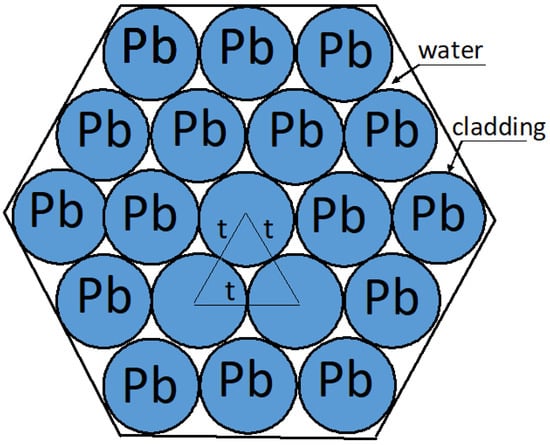
Figure 7.
FA with heavy neutron moderator (lead).
The preferable neutron spectrum can be formed with the highest efficiency by lead isotope 208Pb. Lead isotope 208Pb is characterized by extremely weak neutron absorption (0.23 mbarn in thermal point). This property of 208Pb remains in force within a wide range of neutron energies (from thermal point up to several tens of keV). This characteristic is capable of providing maximal elevation of neutron flux in NpO2-FA. Natural lead contains a relatively large fraction of 208Pb (52.4%). Therefore, this paper discusses two variants: natural lead with 52.4% 208Pb and 100% 208Pb. Natural lead and 208Pb are able to shift the neutron spectrum towards resonance range of 237Np by inelastic neutron scattering, thus intensifying 238Pu production through radiative neutron capture reaction. In addition, application of 208Pb rods can improve some other operation parameters including the higher values of the Doppler effect and longer values of mean prompt neutron lifetime [15].
Preliminary evaluations showed that heterogeneous ID structure could allow us to form a broad zone in the reactor core with high neutron flux and with preferable neutron spectrum for irradiation of 237Np. Hopefully, such a structure opens a possibility for effective and large-scale production of top-quality 238Pu.
2.2. Mathematical Model
The computer code TIME26 [16] was used for neutron-physical analysis of cylindrical VVER-1000 models within the frames of 26-group diffusion approximation. Micro cross-sections were taken from the evaluated nuclear data library ABBN [17] and processed by auxiliary computer code ARAMAKO-S1 to generate self-shielded sets of micro cross-sections in each zone of the reactor core. A geometrical model of the reactor core represents eight annular layers of hexagonal fuel assemblies followed by light-water layer between the reactor core and the reactor vessel (Figure 8). Six cylindrical layers had the same isotope composition, and thus they were characterized by a common set of micro cross-sections.
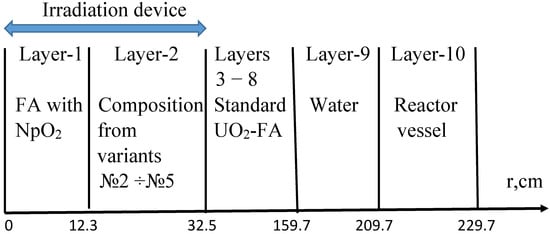
Figure 8.
Cylindrical model of the VVER-1000 reactor.
In computations, the authors tried to find principal physical features of processes occurring in the irradiation device. Therefore, the computations were carried out in simplified one-dimensional cylindrical geometry. Axial leakage was taken into account by using standard geometrical Laplacian. The authors used fresh composition of standard VVER-FA. Control rods in the reactor core were not considered. It is planned that further, more accurate numerical analyses (with application of Monte Carlo codes) will be conducted to confirm the results.
3. Results and Discussion
Analysis of 238Pu production in the irradiation device included the following two mutually linked aspects of the process. The first aspect is related to 238Pu production rate and with plutonium isotope composition. The second aspect is related to the effects of 238Pu production on neutron-physical parameters of the reactor core. One of the most important parameters of VVER-1000 is the displacement damage dose in metal reactor components (cladding of fuel rods and the reactor vessel). Thus, variations of this parameter in the process of 238Pu production require special attention.
3.1. Variants of the ID Design and Evaluations of 238Pu Production
Initial variant of the computations (variant No. 1)—all 163 FA were standard UO2-FA of the reactor VVER-1000 without ID. All the next variants included ID disposition in the core center. Central NpO2-FA was surrounded by six FA with the following compositions:
- Variant No. 2—six standard UO2-FA.
- Variant No. 3—layer of light water.
- Variant No. 4—six FA containing rods with natural lead.
- Variant No. 5—six FA containing rods with 208Pb.
The computations were carried out to determine the main parameters defining plutonium production rate and plutonium isotope composition in central NpO2-FA for all the variants listed above. Pitch of triangular fuel lattice was the same in all variants (t = 12.75 mm). The one-year cycle length was used without accounting for potential outages. The results of the computations are presented in Table 2.

Table 2.
Parameters of plutonium production in the irradiation device.
As was seen, placement of NpO2-FA in the reactor core without lead encirclement led to production of plutonium with large fraction of undesirable isotope 236Pu (variant no. 2). Encirclement of central NpO2-FA by layer of light water (variant no. 3) resulted in the sharp lowering of plutonium production rate. The lowering was caused by elastic neutron scattering by hydrogen. After several collisions, the neutron came into thermal or epithermal energy ranges passing through the resonance range of neutron absorption by 237Np (see Figure 3). Finally, neutron slowing down by light-water resulted in the fact that neutrons come into the energy range with intense plutonium incineration (see Figure 2, energy dependencies of 238Pu micro cross-sections).
Insertion of a lead moderator into six surrounding FA (variant nos. 4–5) significantly improved the plutonium production rate and plutonium isotope composition. In contrast to hydrogen, natural lead and lead isotope 208Pb can slow down neutrons only in a gradual manner, step-by-step, and energy step of neutron slowing down by lead is significantly smaller than that by hydrogen. That is why neutron flux within the energy range of neutron slowing down increased, including the energy range with resonance neutron absorption by 237Np. Within the energy range, micro cross-sections of fission reaction and radiative neutron capture by 237Np remained sufficiently high (see Figure 3), while parasitic neutron absorption by 238Pu became smaller than the same value within the thermal energy range. The noted specific feature of neutron slowing down led to the greater plutonium production rate, as compared with variant 3. It is interesting to note here that lead isotope 207Pb in natural lead composition was the more intense absorber of thermal and resonance neutrons in comparison with lead isotope 208Pb. This circumstance resulted in a slight reduction of plutonium production rate in variant 4 (encirclement of central NpO2-FA by natural lead) as compared with plutonium production rate in variant 5 (encirclement of central NpO2-FA by 208Pb).
As for 236Pu content in plutonium, it is important to slow high-energy fission neutrons down to the values below 6.5 MeV, thus avoiding the negative effect of 237Np(n,2n)236Np-reaction. Within the energy range from 6.5 to 10 MeV, micro cross-sections of neutron scattering by lead isotopes 207Pb and 208Pb were larger than those of hydrogen by a factor of 2.5 on average. Therefore, replacement of light-water encirclement of central NpO2-FA (variant 3) by lead encirclement (variants 4 and 5) resulted in remarkable reduction of 236Pu content in plutonium. However, the required restriction on content of 236Pu in plutonium was not satisfied in all the variants. Fractions of 236Pu were remarkably higher than the acceptable value of 2 ppm.
3.2. Influence of the Pitch of Lead and Neptunium Lattices on the Rate of Plutonium Production and Plutonium Isotope Composition
236Pu fraction in plutonium can be evidently decreased by the softening of the neutron spectrum in central NpO2-FA, i.e., by weakening of 237Np(n,2n)236Pu reaction rate. The computations were carried out with increased pitch of triangular NpO2-rod lattice in central NpO2-FA. The larger pitch resulted in the larger volume fraction of light-water moderator in NpO2-FA and, as a consequence, in the softening of the neutron spectrum.
The computations were carried out to evaluate the effects produced by pitch of tight Pb-rod lattice in Pb-FA on parameters of plutonium production. The data presented in Table 3 demonstrate the variations of plutonium production rate and plutonium isotope composition caused by the increased pitch of Pb-rod lattice under constant pitch of NpO2-rods (t = 12.75 mm). The results showed a very weak effect of Pb-rod pitch variations on parameters of plutonium production in central NpO2-FA. Thus, all the next computations were carried out with constant standard pitch of Pb-rod lattice.

Table 3.
Pitch of NpO2-rods t = 12.75 mm (Np mass = 484 kg).
Then, the computations were carried out to evaluate the variations of plutonium production rate and plutonium isotope composition caused by elongated pitch of NpO2-rod lattice in central NpO2-FA surrounded by six Pb-FA. That is, pitch of NpO2-rod lattice was varied at constant values of NpO2 diameter and thickness of Zr-Nb cladding. Consequently, volume fractions of NpO2, Zr-Nb cladding, and light-water coolant in central FA were changed. The results are presented in Table 4.

Table 4.
Plutonium production rate and plutonium isotope composition caused by elongated pitch sof NpO2-rod lattice (the encirclement by Pb-FAs).
As is seen, the longer pitch of NpO2-rod lattice, i.e., the larger volume fraction of light water in central NpO2-FA, resulted in the lower content of 236Pu, which dropped down below the acceptable value of 2 ppm. Content of 238Pu in plutonium also dropped down, but remained higher than the acceptable value of 85%.
Because of some attractive properties of lead isotope 208Pb, the same computations were carried out for the variants where central NpO2-FA was surrounded by six 208Pb-FA. The results are presented in Table 5.

Table 5.
Plutonium production rate and plutonium isotope composition caused by elongated pitch of NpO2-rod lattice (the encirclement by 208Pb-FAs).
As is seen, replacement of natural lead by lead isotope 208Pb upgraded plutonium production rate on about 25% without its quality degradation.
The computations were carried out to determine the dependence of specific plutonium production rate (Pu mass per mass of initially loaded neptunium) on pitch of NpO2-rod lattice for the variants with encirclement of central NpO2-FA by six Pb-FA and by six 208Pb-FA. The results are presented in Figure 9.
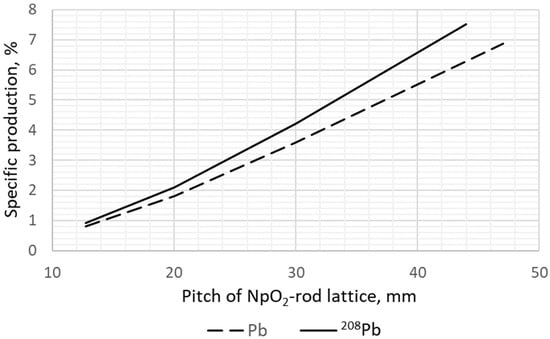
Figure 9.
Dependence of specific plutonium production rate (SPP rate) on pitch of NpO2-rod lattice in central NpO2-FA surrounded by Pb-FA and 208Pb-FA.
As a result of the calculations (Table 3, Table 4 and Table 5, Figure 9), we obtained the following findings on influence of the pitch of lead and neptunium lattices on the rate of plutonium production and plutonium isotope composition:
- Elongation of pitch in tight Pb-rod lattice was not able to produce any remarkable effect on parameters of plutonium production. Thus, all the next computations were carried out with constant standard pitch of Pb-rod lattice.
- If central NpO2-FA is surrounded by six Pb-FA, then the best parameters of plutonium production are achieved at pitch of NpO2-rod lattice t = 47 mm, namely, plutonium production rate—2.45 kg/year, content of 238Pu in plutonium—91.6%, and content of 236Pu in plutonium—1.9 ppm.
- If central NpO2-FA is surrounded by six 208Pb-FA, then the best parameters of plutonium production are achieved at pitch of NpO2-rod lattice t = 44 mm, namely, plutonium production rate—3.06 kg/year, content of 238Pu in plutonium—91.0%, and content of 236Pu in plutonium—1.9 ppm.
- Significant (up to eight times) growth of specific plutonium production rate was evident under gradual elongation of pitch. Specific plutonium production rate in the variant with 208Pb-FA encirclement was higher at about 9% than the analogous value in the variant with Pb-FA encirclement thanks to extremely low neutron absorption ability of lead isotope 208Pb.
3.3. Analysis of the Displacement Damage Dose
Irradiation of the reactor vessel by neutrons coming from the reactor core can cause degradation of its strength properties. The main negative effects on strength properties of the reactor metal structures are related to the loss of the yield strength, loss of ductility, and radiation-induced embrittlement. The displacement damage dose (DDD) in metal reactor components is usually defined by the number of displacements per atom in crystalline lattice per time unit (DPA per year). Energy dependencies of micro cross-sections for the reactions able to displace atoms demonstrate the fact that high-energy neutrons are the main contributors to the degradation of strength properties. This statement is correct for all chemical elements, which can be used as constituents of metal structures in nuclear reactors. Fortunately, the share of fast neutrons in the light-water power reactor cores is rather small and becomes substantially smaller in the vicinity of the reactor vessel. According to the expert estimations, metal structures of nuclear reactors will lose their strength properties when the displacement damage dose reaches the value of 140–150 DPA [18].
Appearance of fuel assemblies, which are relatively transparent for fast neutrons, in the VVER-1000 core can increase fast neutron flux in the reactor vessel and intensify build-up of the displacement damage dose. Only NpO2-FA, Pb-FA, and 208Pb-FA can be transparent for high-energy neutrons.
The computations were carried out to evaluate the negative effect produced by the appearance of relatively transparent (for fast neutrons) fuel assemblies in the reactor core on strength properties of metal structures including the non-repairable reactor vessel. The displacement cross-sections were taken from [19]. The calculation of displacement damage dose was performed as follows. Group-wise DPA cross-sections were multiplied by group-wise neutron fluxes, summed up on energy groups, multiplied by concentration of metal components, and summed up on the metal components. This value was divided by total concentration of the metal components.
The following variants were analyzed: (1) the reactor core without the irradiation device; (2) central NpO2-FA surrounded by six Pb-FA; and (3) central NpO2-FA surrounded by six 208Pb-FA. The gap between the reactor core and the reactor vessel was filled up with light water. The results are presented in Figure 10 and Figure 11.
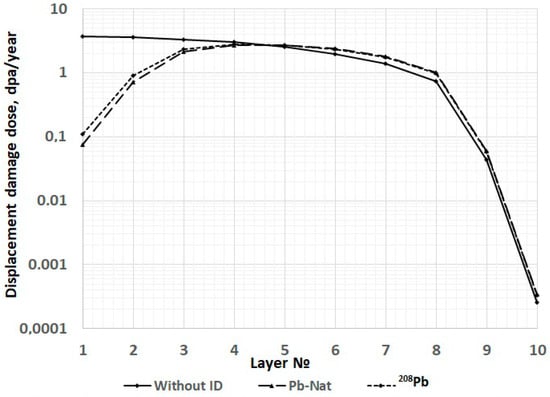
Figure 10.
Displacement damage dose for metal structure of the reactor layers. Layer 10 corresponds to reactor vessel. Water gap thickness (layer 9) was 30 cm.
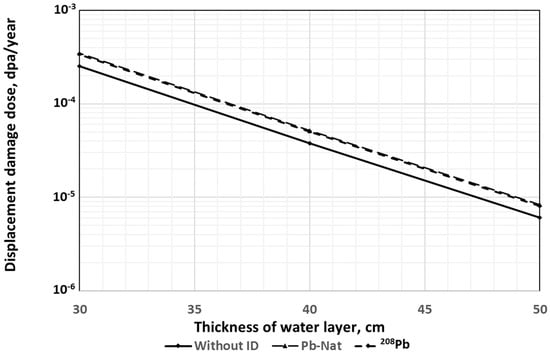
Figure 11.
Displacement damage dose for the reactor vessel under different water gap thicknesses.
As is seen, insertion of the irradiation device in the central zone of the VVER-1000 core did not result in any remarkable growth of the displacement damage dose in the reactor vessel. Specifically, DDD for the reactor vessel increased by 5% when the ID was placed into the reactor core.
Figure 11 shows the change in value of the DDD for the reactor vessel with an increase in thickness of the water layer (layer 9) from 30 to 50 cm.
As is seen, insertion of the irradiation device in central zone of the VVER-1000 core did not result in any remarkable growth of the displacement damage dose in the reactor vessel. During full reactor lifetime (about 60 years), strength properties of the reactor vessel remain at the satisfactory level, i.e., the number of displacements per atom remains substantially below the acceptable value [18].
4. Conclusions
The numerical results obtained in the computations allowed us to make the following conclusions:
- The absence of effective neutron moderator around central NpO2-FA results in plutonium production with an unacceptably large content of undesirable isotope 236Pu (its fraction exceeds the acceptable value by a factor of 60).
- If central NpO2-FA is surrounded by a light-water layer, then the plutonium production rate decreases by a factor of 4, while 236Pu content drops down significantly.
- Six 208Pb-FA around of central NpO2-FA are more transparent for slow neutrons coming from the reactor core than six Pb-FA. That is why replacement of natural lead by lead isotope 208Pb in six assemblies around of central NpO2-FA increases the plutonium production rate from 3.76 kg/year up to 4.24 kg/year at the same content of undesirable isotope 236Pu. Content of 236Pu remains unacceptably large (higher than the acceptable value by one order of magnitude).
- The best positive effect on parameters of plutonium production can be produced by more spacious lattice of NpO2-rods in central NpO2-FA. The larger pitch of triangular NpO2-rod lattice results in the lower content of 236Pu in plutonium (below 2 ppm), while content of 238Pu remains sufficiently high (above 85%).
- The larger volume fraction of light water in central NpO2-FA results in remarkable (up to eight times) growth of specific plutonium production rate. Replacement of natural lead by lead isotope 208Pb in the surrounding Pb-FA provides an additional elevation of specific plutonium production rate on ≈9%.
Analysis of the results obtained in the computations of the displacement damage dose in metal claddings and in the reactor vessel allowed us to make the following conclusions:
- 6.
- Thickness of the light-water gap between the reactor core and the reactor vessel produces no practical effect on the displacement damage dose in the reactor core. The lower thickness of the light-water gap can substantially increase the displacement damage dose in the reactor vessel only.
- 7.
- Replacement of natural lead by lead isotope 208Pb in six FA around the central NpO2-FA can insignificantly decrease the displacement damage dose in the reactor vessel because of the better neutron slowing down properties of 208Pb.
- 8.
- The displacement damage dose in the reactor vessel remains at a sufficiently low level and provides conservation of its strength properties during full reactor lifetime (up to 60 years).
Author Contributions
Conceptualization, A.N.S. and N.I.G.; methodology, A.N.S., G.G.K. and V.A.A.; software, V.A.A.; analysis, G.G.K.; writing—original draft preparation, E.G.K. and V.B.G.; visualization, V.B.G. All authors have read and agreed to the published version of the manuscript.
Funding
The works have been performed within the frames of the grant given by the Russian Scientific Fund, Project No. 22-22—00287.
Data Availability Statement
Not applicable.
Conflicts of Interest
The authors declare no conflict of interest.
References
- Daily, C.R.; McDuffee, J.L. Design studies for the optimization of 238Pu production in NpO2 targets irradiated at the High Flux Isotope Reactor. Nucl. Technol. 2022, 206, 1182–1194. [Google Scholar] [CrossRef]
- Colvin, E.; Rhodes, J.H.; Marcantel, G.A.; Kajihara, T. Optimization of plutonium-238 production in the Advanced Test Reactor for radioisotope thermoelectric generators in deep space exploration applications. In Proceedings of the Conference on Nuclear and Emerging Technologies for Space (NETS), Richland, WA, USA, 25–28 February 2019; Available online: https://www.researchgate.net/publication/332182780 (accessed on 15 September 2022).
- INFCIRC/153. The Structure and Content of Agreements between the Agency and States Required in Connection with the Treaty on the Non-Proliferation of Nuclear Weapons; IAEA: Vienna, Austria, 2008; p. 29. [Google Scholar]
- Shmelev, A.N.; Geraskin, N.I.; Kulikov, G.G.; Kulikov, E.G.; Apse, V.A.; Glebov, V.B. The problem of large-scale production of plutonium-238 for autonomous energy sources. J. Phys. Conf. Ser. 2020, 1689, 012030. [Google Scholar] [CrossRef]
- Stoimost-Plutoniya. Available online: https://skolko-poluchaet.ru/skolko-stoit/stoimost-plutoniya.html (accessed on 15 September 2022).
- Shibata, K.; Iwamoto, O.; Nakagawa, T.; Iwamoto, N.; Ichihara, A.; Kunieda, S.; Chiba, S.; Furutaka, K.; Otuka, N.; Ohsawa, T.; et al. JENDL-4.0: A New Library for Nuclear Science and Engineering. J. Nucl. Sci. Technol. 2011, 48, 1–30. [Google Scholar] [CrossRef]
- Ralf, L.M., Jr. Radioisotope Power Systems for Deep Space Exploration–Some Background. March 2021. Available online: https://www.nationalacademies.org/event/03-05-2021/docs/D7D82520CDCFA8423E16CD569643B93B8837DDEA9EDB (accessed on 15 September 2022).
- Experience of the RF Specialists in Hydrography Can Speed up Removal of RITEG Residuals from the Northern Sea Way–RIA News, 13 January 2012. Available online: http://www.atominfo.ru/news9/i0545.htm (accessed on 15 September 2022). (In Russian).
- Interview with Vitaly Sadovnikov, General Director of MAYAK Production Association: From “Annushka” and “Ivanov” to “Ruslan” and “Lyudmila”. Available online: https://www.pravda.ru/eureka/31061-reaktor (accessed on 15 September 2022).
- Russian Plutonium Did Not Last for Pentagon Needs. Available online: https://lenta.ru/articles/2005/06/28/plutonium/ (accessed on 15 September 2022). (In Russian).
- Production Association “Mayak” Started Designing the Newest Research Reactor. Available online: https://tass.ru/ural-news/2304431 (accessed on 15 September 2022). (In Russian).
- Betzler, B.R.; Chandler, D.; Evans, T.M.; Davidson, G.G.; Daily, C.R.; Wilson, S.C.; Mosher, S.W. As-Built Simulation of the High Flux Isotope Reactor. J. Nucl. Eng. 2021, 2, 28–34. [Google Scholar] [CrossRef]
- DePaoli, D.; Benker, D.; Delmau, L.; Sherman, S.; Riley, F.; Bailey, P.; Collins, E.; Wham, R. Nuclear and Emerging Technologies for Space. In Proceedings of the American Nuclear Society Topical Meeting, Richland, WA, USA, 25–28 February 2019; Available online: http://anstd.ans.org/NETS-2019-Papers/Track-5--Radioisotope-Power-Systems/abstract-80-0.pdf (accessed on 15 September 2022).
- ROSATOM. The VVER Today: Evolution, Design, Safety. 2013. Available online: https://www.rosatom.ru/upload/iblock/0be/0be1220af25741375138ecd1afb18743.pdf (accessed on 15 September 2022).
- Shmelev, A.N.; Kulikov, G.G.; Kryuchkov, E.F.; Apse, V.A.; Kulikov, E.G. Application of Radiogenic Lead with Dominant Content of 208Pb for Long Prompt Neutron Lifetime in Fast Reactor. Nucl. Technol. 2013, 183, 409–426. [Google Scholar] [CrossRef]
- Kuzmin, A.M.; Shmelev, A.N.; Apse, V.A. Modeling of Physical Processes in Fast Nuclear Power Reactors; Publishing House of Moscow Power Engineering Institute: Moscow, Russia, 2015; p. 50. [Google Scholar]
- Janis. Nuclear Energy Agency. Available online: https://www.oecd-nea.org/jcms/pl_39910/janis (accessed on 15 September 2022).
- Makhin, V.M.; Tsofin, V.I.; Komolov, V.M.; Galandinov, A.D. Evaluation of damage dose rates in structural materials under various irradiation conditions. In Problems of Atomic Science and Techniques; NPP Safety Assurance; Russian National Center “Kurchatov Institute”: Moscow, Russia, 2009; pp. 135–140. [Google Scholar]
- Beskorovainy, N.M.; Belomytsev, Y.S.; Abramovich, M.D.; Jvanov, V.K.; Shulepov, V.I. Structural Materials of Nuclear Power Reactors. In Training Manual for Higher Schools; Atomizdat: Moscow, Russia, 1977. (In Russian) [Google Scholar]
Publisher’s Note: MDPI stays neutral with regard to jurisdictional claims in published maps and institutional affiliations. |
© 2022 by the authors. Licensee MDPI, Basel, Switzerland. This article is an open access article distributed under the terms and conditions of the Creative Commons Attribution (CC BY) license (https://creativecommons.org/licenses/by/4.0/).